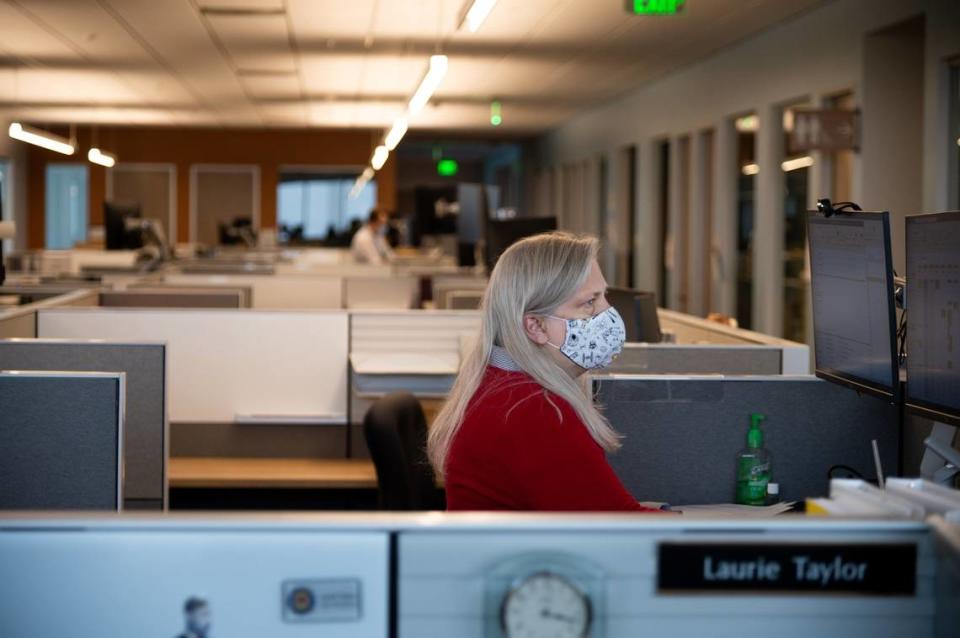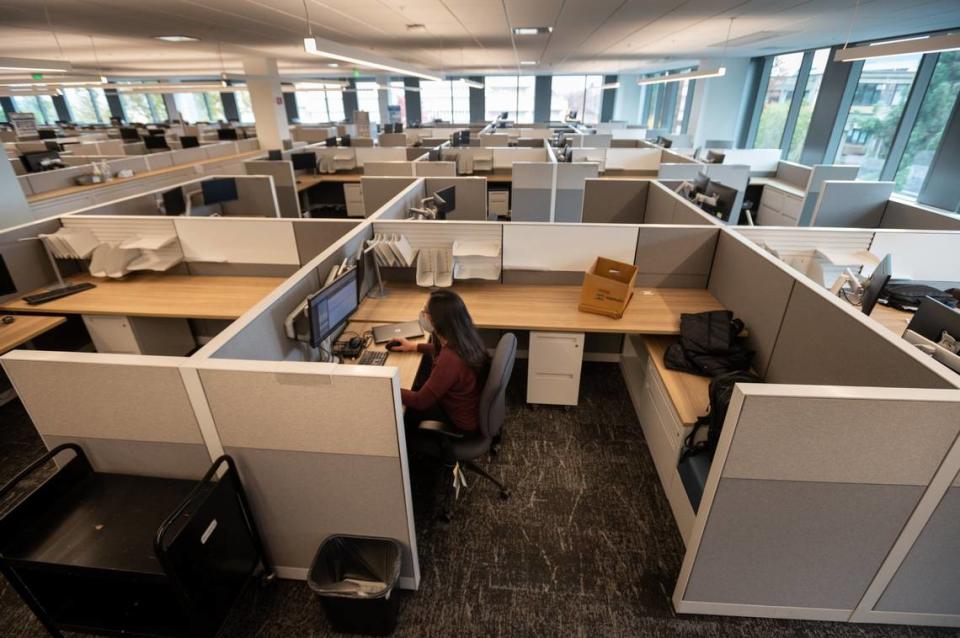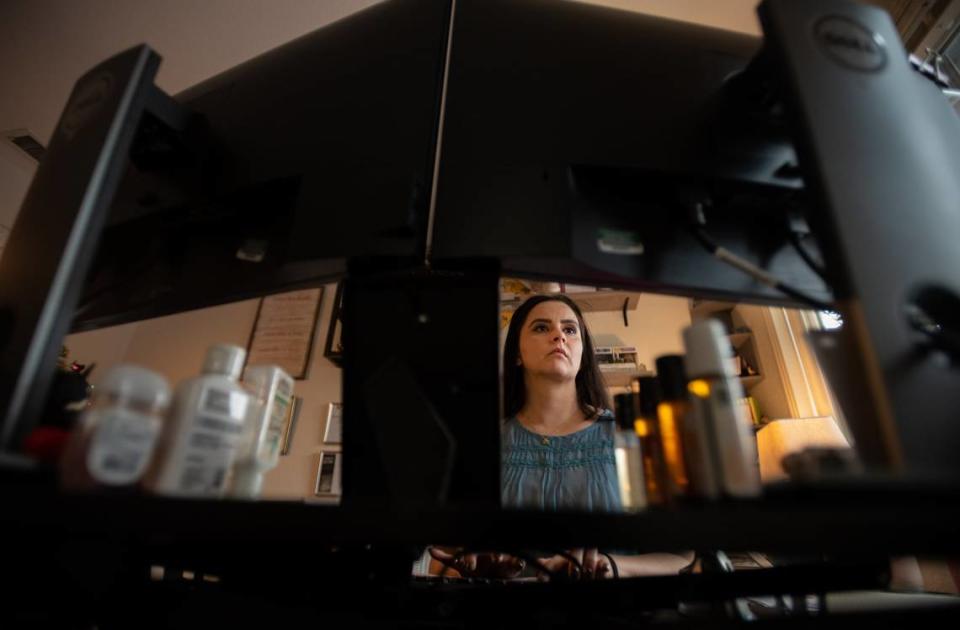Return to office: State workers say looming mandate would cost more than money
- Oops!Something went wrong.Please try again later.
Matt Williams has never worked a hybrid schedule before — only 100% in person or 100% telework from his home. The latter, he said, benefits both state employees and California taxpayers.
For four years before the COVID-19 pandemic in March 2020, Williams drove each day from his home in Elk Grove to the California Air Resources Board’s office in downtown Sacramento — roughly a 30- to 50-minute commute each way.
The COVID lockdown shuttered most state offices, and Williams and thousands of other state workers found themselves working from home nearly full-time.
Not having to go into the office every day allowed Williams, an air pollution specialist, to “walk the talk” when it came to reducing his carbon footprint. He moved to midtown and sold his car. Now, he gets around either on foot or by bicycle.
But this spring, Williams would be just one of tens of thousands of employees called back to their offices twice a week as state agencies push return-to-office plans.
The California Environmental Protection Agency, which oversees CARB among other boards, offices and departments, has told its employees to plan for two days a week in-office starting sometime in March. The California Health and Human Services Agency, as well as the Employment Development Department, have issued similar announcements. The agencies must meet and confer with state employee unions before implementing any changes.
“I know many of you are curious to know the ‘why’ behind this shift,” said CalEPA Secretary Yana Garcia in an all-staff meeting Wednesday morning. “And the truth is, there are many ‘why’s.’”
Garcia touted what she saw as the “critical opportunities” that in-person work provides — mentorship and networking for early-career employees and knowledge-sharing through impromptu hallway conversations, among them.
But, by and large, state workers said they aren’t sold on the aforementioned benefits of in-office work.
Common themes from the more than 500 responses to a Sacramento Bee return-to-office survey include less time spent with family, and more stress, money and time spent on commuting.
The majority of those who volunteered their thoughts in the survey gave myriad reasons why such a mandate, even if for just two days a week, would make them unhappy. The costs of changing their routines after four years of remote work also varied — factors parking and gas prices frequently cited.
Altering schedules to accommodate young children, dogs and aging parents brought them another dimension of stress.
Respondents also criticized the state’s reasoning for bringing people back in person — which includes buzzy phrases such as “fostering collaboration” and “improving workplace culture.” They believe the state, facing an estimated $38 billion budget deficit, is adding costs.
“We don’t see any benefits from coming into the office,” Williams said. “All we see are costs.”
One state worker who took the survey summed it up: “There are no positives.”

Work performance isn’t a factor
Employees also say departments have provided no evidence that worker performance has dipped due to telework. The agencies concede that performance factors had no bearing on the decision to bring people back.
“This is not meant to address any deficiency or performance issue,” wrote CalHHS spokeswoman Sami Gallegos in response to The Bee’s questions, “but an opportunity to strengthen and improve existing dynamics.”
Williams acknowledged he won’t battle the same lengthy commutes that many of his colleagues would on their way to work. Nor would he have to buy a car to get to and from the office, because he lives in a walkable neighborhood.
His concerns run deeper than the inconveniences that return-to-office imposes. Several of Williams’ colleagues who were hired after the embrace of telework are based in places that don’t have easy access to a CARB office or satellite location. He worried that mandated in-office work would hamper the department’s ability to recruit and retain a racially, socioeconomically and geographically diverse workforce.
“The programs we implement affect people. And the effects should be equitable,” he said. “It’s important that those voices be integral to our decision-making.
“The best employees — the ones we need — are also the ones with options. They will have no trouble getting another job.”
Williams thinks about how taxpayers will ultimately foot the bill. Any extra office space or necessary equipment would cost taxpayer dollars. Plus, more in-office work means more commuters on the road, and more drivers means more congestion and emissions.
The Department of General Services’ Telework Tracker estimated that CalEPA, CalHHS and EDD employees together saved more 20 million commute miles and avoided 7,384 metric tons of carbon dioxide emissions in November 2023, the latest month for which data is available. The tracker also estimated a per-worker vehicle expense savings of between $416 and $465 for employees within those three state organizations.
As part of his ambitious statewide climate goals, Gov. Gavin Newsom has targeted statewide operations for emissions reduction. He signed a 2022 law that requires state operations to achieve net-zero emissions by 2035.
The irony of CARB employees contributing to greenhouse gas emissions with their commutes isn’t lost on Williams.
“It’s not just hypocritical. It’s entirely contrary to our mission,” he said. “It’s wrong.”
Am I exempt from in-office mandate? No one knows
Departments that recently announced their return-to-office plans have offered few details about when, how and which workers are expected to report in-person twice a week. EDD issued an FAQ that qualifies most answers with some variation of, “Please discuss with your supervisor.”
Concrete details most likely won’t be released until after the departments meet and confer with the state employee unions. In the meantime, state workers are left wondering how they will need to rearrange their lives around in-office work.
Several respondents to The Bee’s survey said they would need to buy a car to get to their desks. Others wondered whether they would be exempt from the order given how far away they live from the office.
One manager at the Department of Public Health, who is not union-represented and asked to remain unnamed due to fears of retaliation, said at least half of her 10-person team is based outside of Sacramento. In her nearly 10 years with the department, she said the team has struggled to fill positions largely due to non-competitive salaries. The ability to telework was a big selling point, and she’s since been able to hire talented people from across the state.

For teams with out-of-town members, in-office days won’t necessarily increase collaboration or foster a richer workplace culture, she said.
“We’ll be on Zoom from the office in separate rooms,” the CDPH manager said. She added that she’s “very worried” that members of her team will quit and can’t stand the thought of losing them over “something this silly,” especially when they collaborated effectively via telework.
Some workers lamented that coming back to the office, even two days a week, would hinder whatever productive gains they found during the pandemic.
One worker from the Department of Health Care Services living in Solano County said the office wasn’t exactly a place to find focus.
“In-office work causes more distractions, you hear others talking nearby,” she said in the survey. ”Then you have to hear your cubicle neighbor’s Zoom call. I am way more productive at home teleworking in the comfort of my own home. I am also a much happier employee.
“Once a month in the office for team building is great. Any more is unnecessary,” she said.
Even without clear implementation guidance, some workers said they felt they had no choice but to plan for a potential return to their offices March 1.
“I have to prepare for the worst basically,” said one IT professional working in a CalHHS department who also feared retaliation. “I’ve gotten zero communication on whether or not they can work with me.”
Six months ago, he moved his family to Wheatland from Rocklin; he lives with and helps care for his aging parents, taking them to doctor’s appointments and assisting with tasks around the house.
“My main concern is if my mother has a health issue or emergency and I’m not here to facilitate care for her,” he said. “She’s already had a couple of scares where I’ve had to take her to the hospital before, or at least assist my father with doing so.”
A two-day in-office mandate means introducing a 75-mile round-trip drive twice a week — putting him an hour from home during peak traffic times.
His gas-guzzling pick-up is another consideration. While he has an older sedan that gets better gas mileage, but it would require new registration, insurance and maintenance to make it roadworthy. And he said he doesn’t have the money to get a new ride.
“I do not have the money nor the credit at the moment to go and spend $30-$40,000 on a new vehicle,” he said. “I’m having to spend money to put another vehicle on the road while getting rid of a different one.”
How much will return-to-office cost?
Cost estimates for individual workers vary widely, but the consensus among respondents to The Bee’s survey is that the return to office comes at a price. Readers estimated they would need to budget anywhere from a few hundred dollars a month for parking and fuel to more than a thousand dollars monthly for those who need to buy another car or pay for child care.
“I’m worried my family will not be able to make ends meet as well now that we will have to pay more for child care,” said one respondent who works in the Department of Tax and Fee Administration and was afraid to speak publicly. “I have family that takes care of my toddler when I work from home but I cannot leave my child with them while I’m away due to medical issues. I have another child in school and, now, I will have to find child care for them to get to and from school due to my commute.”
She estimated her family would need another $2,000 in net income for a second car, saying any added costs would “push us to our absolute limit financially.”
“I greatly appreciated being able to work from home with no commute,” she said. “I was able to spend more time with my family and be a more involved mother and afford to live decently.”
Otherwise, she admitted, “I just don’t know how we’re going to make it.”

Because departments have yet to meet and confer with unions, how much a mandate could cost the state is hard to determine. Critics of the push have pointed to a Department of Finance budget letter earlier this year that instructed departments and agencies to freeze unnecessary spending.
H.D. Palmer, a spokesman for the state’s finance department, said return-to-office plans would not conflict with the budget letter. Although equipment varies by department, Palmer said, the majority of state employees have state-provided laptops and cellphones that allow them to shuttle their work between places. Employees who have been provided with equipment for reasonable accommodations, such as ergonomic chairs and desks, would not be expected to transport those to and fro, he said.
“The process has been designed so that we can address any and all legitimate contingencies that may arise from this,” Palmer said. “That is why there are provisions allowed in the budget letter for the acquisition of ‘mission critical’ equipment.’”
Whether bringing employees back to the office twice a week counts as “mission critical” depends on whom you talk to. Agency and departmental leaders say yes, but employees like the CalHHS IT worker from Wheatland don’t agree. A large part of his job involves outfitting his colleagues with laptops and other workstation equipment.
“I will not sign off on any justification that says that this is mission-critical when it’s not,” he said. “I can’t lie on a form.”
Ted Toppin, executive director of the Professional Engineers in California Government, also questioned why the state is bringing back thousands of employees without demonstrating an operational need. He said his union would fight the in-office mandates “with all our might” and advocate with the administration “from the Governor’s Office on down.”
He left the door open to legal action, if necessary, including filing grievances challenging the two-day mandates if it came to that.
“Outdated thinking dies hard — this notion that collaboration and team-building are done in offices filled with cubicle farms is just not how PECG members think about it anymore,” Toppin said. “They’ve seen the future, and it’s on Zoom. It’s on Slack. It’s on virtual platforms where they can be in constant communication with their teams across the state.”

